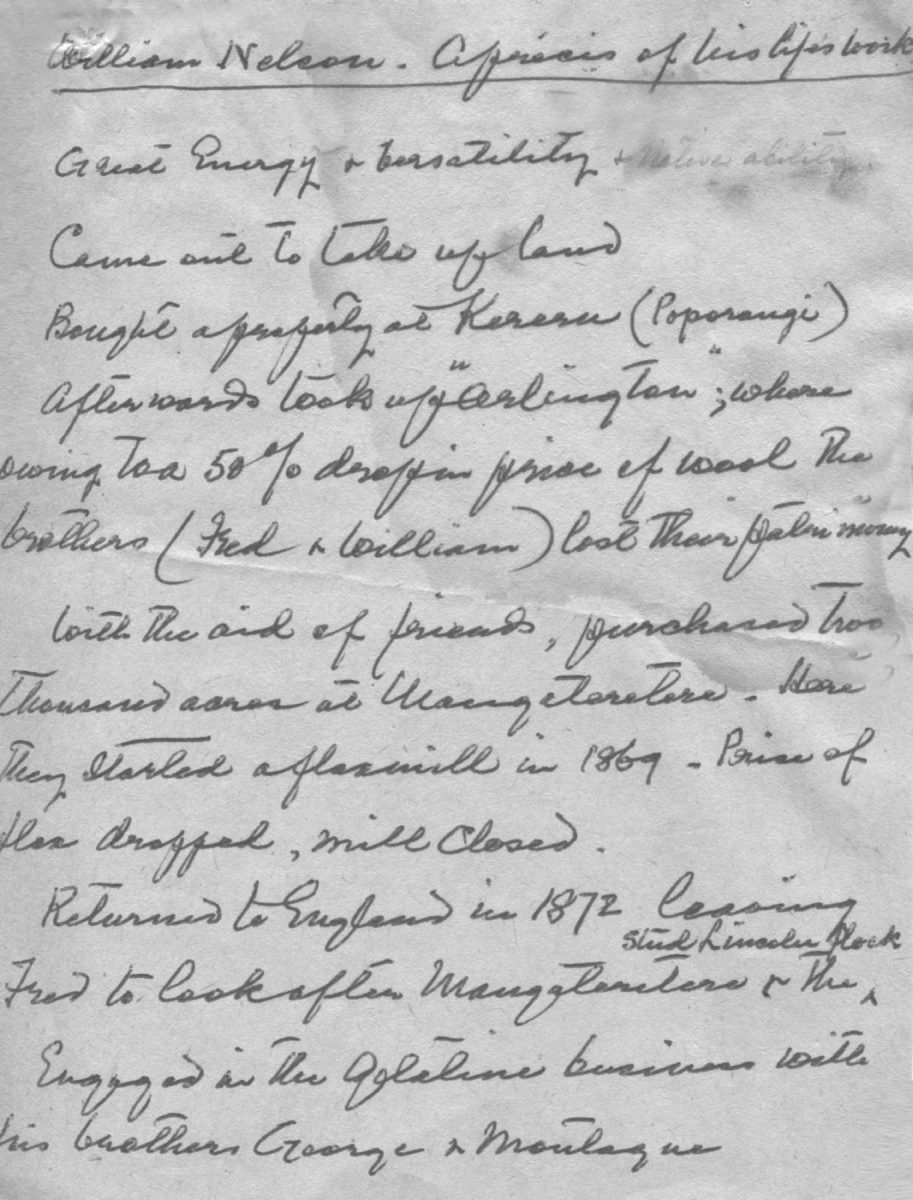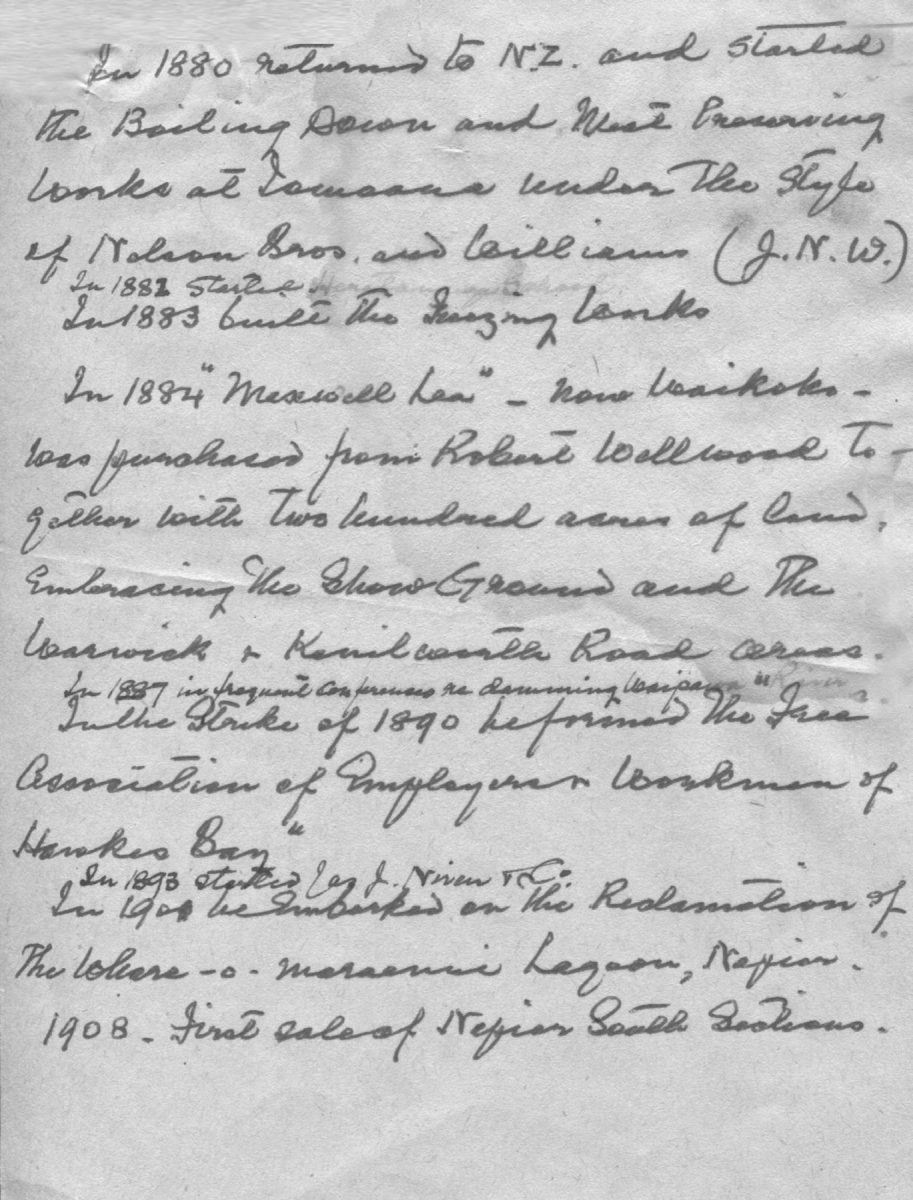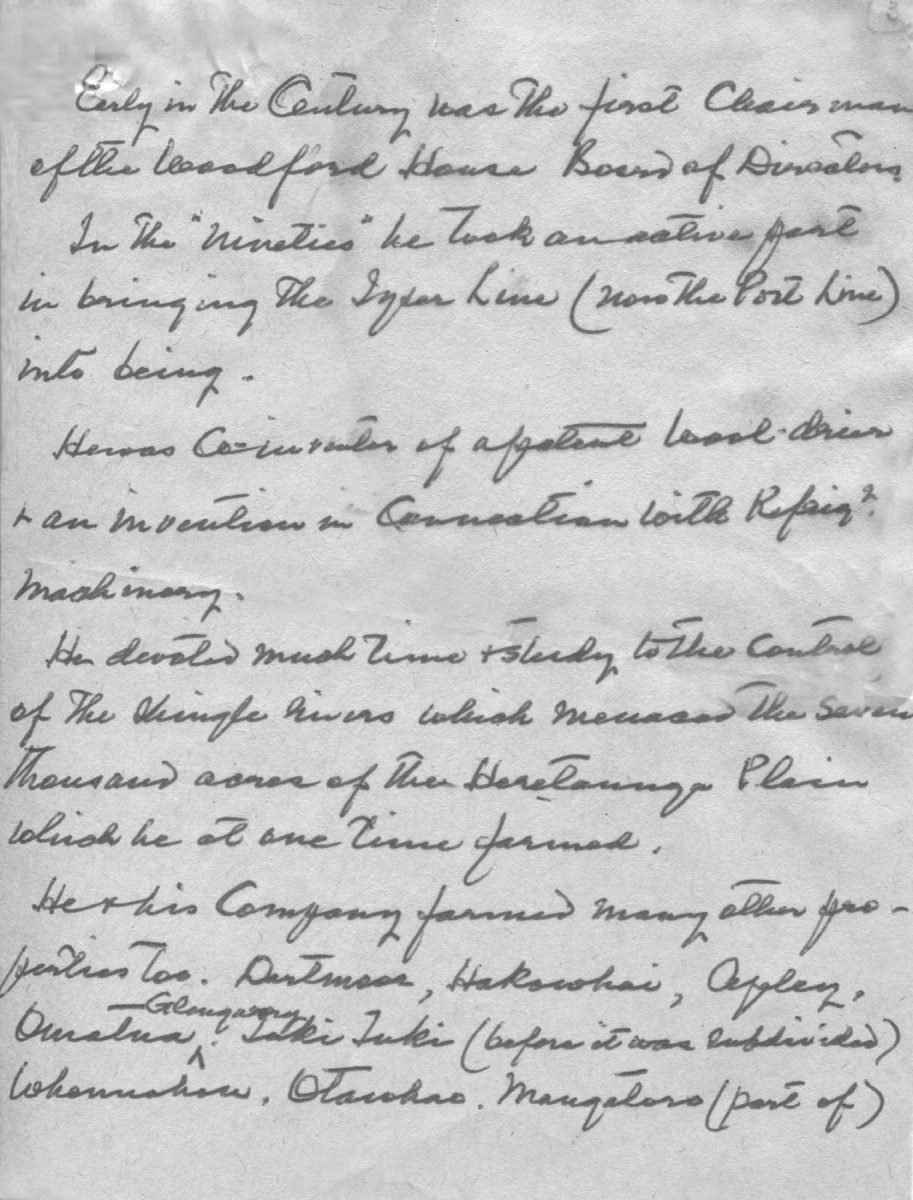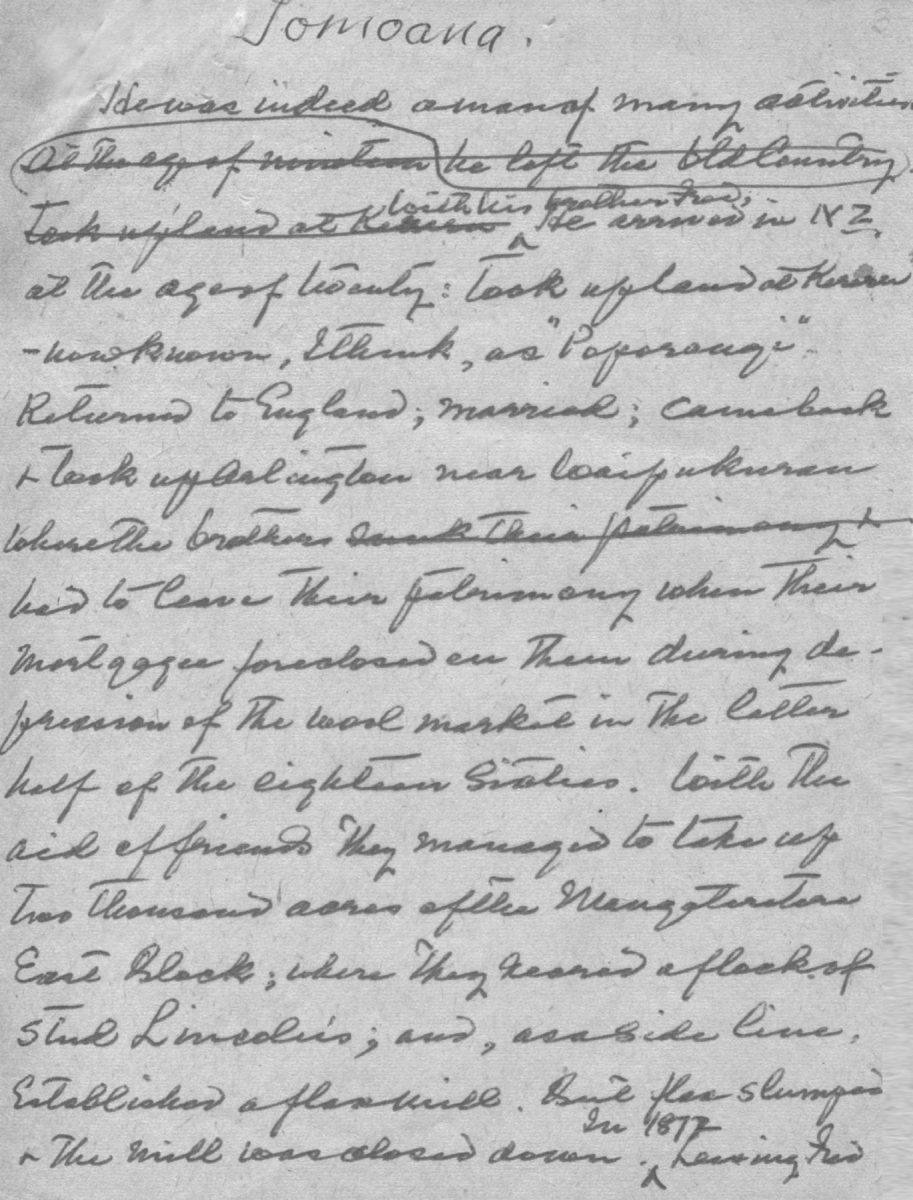- Home
- Collections
- WALMSLEY MJ
- William Nelson of Tomoana
- William Nelson Biography 2
William Nelson Biography 2
William Nelson – A précis of his life’s work
Great Energy & versatility & versability
Came out to take up land
Bought a property at Kereru (Poporangi)
Afterwards took up “Arlington”, where owing to a 50% drop in price of wool the brothers (Fred & William) lost their patrimony.
With the aid of friends, purchased two thousand acres at Mangateretere. Here they started a flax mill in 1869. Price of flax dropped, mill closed.
Returned to England in 1872 leaving Fred to look after Mangateretere & the stud Lincoln stock.
Engaged in the gelatine business with his brothers George & Montague.

In 1880 returned to NZ and started the Boiling Down and Meat Processing Works at Tomoana under the style of Nelson Bros. and Williams (J.N.W.)
In 1882 started in 1883 built the Freezing Works.
In 1884 “Maxwell Lea” – now Waikoko – was purchased from Robert Wellwood together with two hundred acres of land, embracing the Showground and the Warwick & Kenilworth Road areas.
In 1887 infrequent conferences re damming Waipawa River
In the Strike of 1890 he formed the “Free Association of Employers & Workmen of Hawkes Bay.”
In 1893 started J.& J. Niven & Co.
In 1901 he embarked on the Reclamation of the Whare-o-maraenui Lagoon, Napier.
1908 First sale of Napier South Sections

Early in the Century was the first Chairman of the Woodford House Board of Directors.
In the “nineties” he took an active part in bringing the Infer Line (now the Port Line) into being.
He was Co-inventor of a patent wool-drier & an invention in connection with Refrig. machinery.
He devoted much time & study to the control of the shingle rivers which menaced the seven thousand acres of the Heretaunga Plain which he at one time farmed.
He & his Company farmed many other properties too. Dartmoor, Hakowhai, Ayley, Omatua, Glengarry, Tuki Tuki (before it was subdivided), Whenuahou, Otawhao, Mangatoro (part of)

Tomoana
He was indeed a man of many activities.
With his brother Fred he arrived in NZ at the age of twenty: took up land at Kereru – now known, I think, as “Poporangi”. Returned to England; married; came back & took up Arlington near Waipukurau, where the brothers had to leave their patrimony when their mortgagee foreclosed on them during depression of the wool market in the latter half of the eighteen sixties. With the aid of friends they managed to take up two thousand acres of the Mangateretere East Block; where they reared a flock of stud Lincoln’s; and, as a side line, established a flax mill. But flax slumped & the mill was closed down. In 1872 leaving Fred

in charge of the property, William retd. to England & engaged with his brothers George & Montague in the manufacture of gelatine. Until, in 1880, he returned to New Zealand to establish the Works at Tomoana, the history of which is, I think, well known. Though perhaps the manner in which it came by its name is not so well known: it came about in wiser –
As the people of Waipatu would benefit by access to the recently formed constructed railway, William thought that if he formed & metalled the road they might reasonably be expected to contribute the land. The bargain was clinched by the undertaking to name the Works for the Chieftain of Waipatu – Henare Tomoana.

Amongst his activities were the establishment of the Heretaunga School, Hastings, under the direction of Wm. Rainbow, which opened in February 1882 on the site now known as Nelson Park with four of his sons as foundation members. He was too, first Chairman of the Board of Directors of Woodford House School for Girls in Havelock North.

William Nelson left his home in Warwick, England for the new land which was to become the scene of the major part of his life’s work, in October 1862. Then nineteen years of age he had already gained some knowledge of the manufacture of cement and of gelatine and of leather: practical experience which was to stand him in good stead in the work of his later life.
Landing in Auckland the day before the wreck of H.M.S. Orpheus on Manukau Bar: finding the Country in a very unsettled state, he, with his brother Fred, enlisted with the militia then being enrolled & trained for Emergencies. In the intervals between these [?] and the time spent on acquiring knowledge of the potentialities of the Country to the North & to the South of that centre, William spent his time making rough furniture & otherwise preparing for the life of a pioneer on the land.

After a tour of inspection in the South, the brothers came to Hawkes Bay where they took up a property adjoining their friend J.N. Williams at Kereru. That property – referred to in William’s diary as “Brown’s Lodge” – eventually came into the hands of John Anderson, whose heirs have lately sold it for Soldier Settlement. After a visit to England in 1865 to marry his Warwickshire sweetheart, Sarah Newcombe Bicknell, he returned to settle down at “Arlington” near Waipukurau. Here, the combined effect of a serious fall in the price of wool supplemented by a plague of grasshoppers robbed the brothers of their inheritance: unable to meet the interest charges on their Mortgage they had to walk off, leaving their patrimoney behind them.
By means unknown to the writer, they managed to get a

The house which he [?] occupied had a history: here it is amongst the old gentleman’s many relatives he had a cousin; Maria Wayre, wife of the Revd. John Townsend (Vicar of St. John’s, Napier in the ’sixties) for whom he planned to make a home. The site chosen was on the right bank of the Tutaekuri River a few chains above where the Meeanee Bridge used to be. While the building was in progress came “old Powdrell” who, surveying the proceedings with both years & experience on his side, turned to the young settler with the remark “I wouldn’t build my house there, young man: not if I were you.” The young man’s response was “That’s all right”. Telling the story to the writer in later years Father William observed “I soon found

In April 1871 we find Wm. Nelson gazetted a boardman of the Te Mata Road Bd.
In March of the following year he disposed of his furniture and left for England with his wife and four children by the Sailing Ship Queen Bea, a vessel of about 700 tons.
Back in Warwick, he joined his brothers in the gelatine business; until, in July 1880, accompanied by his wife and two members of his young family – now grown to nine – he embarked on the “Sorata”; was wrecked in the Back Stairs Passage, coming out of Adelaide; finally reaching Napier in time to “turn the first sod” in the establishment of the works to which he gave the name of “Tomoana” to commemorate the generosity of Henare Tomoana, the Chief of Waipatu, who gave a half-chain road from the Karamu Road to across the railway. This road, widened & extended

to Pakowhai Road was, later, named Elwood Road, in memory of John Patrick Elwood who, as Engineer & Architect was Wm. Nelson’s right-hand-man in the various works which he planned from the year 1880 onwards.
The original works at Tomoana were designed to deal with the surplus stock of the district by the then well-approved methods of “canning” & “tallow-rendering.” The sheep-skins were hung up in “sweat-houses” until the wool was ready to come away from the pelt.
The works were built on part of Mr J.N. Williams’s property & the style of the Firm was “Nelson Bros. & Williams.”

It was after Thomas Brydon, General Manager of the New Zealand & Australian Land Co., had demonstrated the possibilities of the “Congealing process”, when the sailing ship “Dunedin” landed her cargo of frozen meat in London in good condition, that others got busy. The “Dunedin” left New Zealand in 1882 & in the following year “Nelson Bros & Williams” sold out to “Nelson Bros”, a limited liability Company with ample means, and “Freezing Works” were added to the Enterprise at Tomoana. The original Freezing Works were laid out to handle four hundred sheep a day. “Four hundred sheep a day”, gasped the owner of “Frimley”: adding “Why Gull, there soon won’t be a sheep left in the district!” (“Gull” was the name by which he was known amongst the intimates of his boyhood: it was short for “Gulliver”- of “Gulliver’s Travels”, a book of which he was fond, as a lad.)

Titoki 2000 acres
Tuki Tuki 11000
Whenuahou 7000
Otarohao (lease)
Waipuna
Hukanui
Hakowhai
Dartmoor
Apley
Mt. Cameron
Omatua
Eskmount
Glengarry
About 30,000 acres
Loch Inver About 30,000 acres (lease)
On the Heretaunga Plain
Mangateretere 2000 acres
Tomoana F.
Chesterhope 1800 acres
Oakleigh
Papakura
Waima
About 7000 acres
This is a list of sheep-stations controlled by Wm. Nelson at one time or another. When the graduated tax on land came in, most of the properties had to be sold.
L.N.Nelson
October 1949

George Nelson of Warwick; born 5th June 1800, died 17th July 1850; married Sarah Philbrick, of an Essex family; born 25th June 1798, died 14th December 1865. Both buried in Milverton Churchyard, Warwick.
Their family consisted of: –
Charles 7th January 1834 – 14th August 1877
Laura (died young)
George H. 13th April 1837 – 5th March 1898
Frederick 8th April 1839 – 26th Feb. 1908
Edward Montague 5th March 1841 – 4th Feb. 1919
William 15th Feb. 1843 – 16th Nov. 1932

William, with his brother, Fred, migrated to N.Z. in October 1862. Arriving at Auckland early in Feb. 1863. The brothers eventually bought a property at Kereru, Hawkes Bay; whence they – or, at all events, William – moved to “Arlington”, near Waipukurau, in 1866, where they took up some 14,000 acres of sheep country. Here misfortune overtook them &, the mortgage foreclosing, they had to get off the place, leaving most of their patrimony behind them. At Arlington were born William Henry, 11th September 1866; and Ida Maud 15th May 1868.

We next find the brothers on the Mangateretere East Block of 2,000 acres of the rich Heretaunga Plain. The elder brother making his home on the main road about four miles on the Napier side of Havelock. At the woolshed and yards adjoining, was held one of the early “shows” in the ’Sixties.
William made his home about a mile away in the direction of Clive, calling it “The Lawn”. Here were born his sons Frederick Montague (23.10.69 – 29.10.28) and George (30.9.71). In March 1872 we find the Hawkes Bay Herald advertising the sale of the furniture at “The Lawn”

William, the youngest of the five sons of George Nelson, gelatine manufacturer of Warwick, England, and Sarah Philbrick of an Essex family, was born at Warwick on 15 February 1943 [1843]. At the age of nineteen, having in the meantime acquired a practical knowledge of the manufacture of gelatine, leather and cement, in company with his brother Fred he sailed for NZ in the ship Devonshire, leaving the Thames 26 October 1962 [1862] and arriving at Auckland on 7th February: the day H.M.S. Orpheus

William Nelson was born at Warwick, England on 15th February 1843. He was the youngest of the five sons of George Nelson of that Town inventor & manufacturer of Nelson’s Gelatine, of that Town. His early years were an active training for the work of his after life. After a few years at the Warwick Grammar School he went to work in his Uncle’s Tannery, transferring thence to the Cement Works of his brother, Charles Nelson of Stockton, near Rugby. This experience thus gained, together with such as he picked up in the gelatine works furnished the business equipment with which at the age of 19 he sailed for New Zealand with his brother Fred aboard the ship “Devonshire” of 807 tons.
When the ship reached Auckland, February 1863, trouble with the Maoris being there afoot, they joined the militia & were sent into the Waikato. Thence they found their way to Hawkes Bay.
Arrived at the scene of their life’s work, the brothers Nelson looking around for an investment set out on horseback in company with Mr. J.N. Williams. After traversing the Heretaunga Plains they passed through Maraekakaho & Aorangi

to Kereru, where they settled down; Mr Williams taking the land now owned by [?] Turnbull & the Nelsons settling on that now the property of the Anderson family. It is interesting here to note that at that time the state of the Heretaunga Plain was such that [?] so keen an observer as William Nelson classed it as either swamp or shingle! That was ten years before Hastings was put on the map. The Main south Road avoided the Swamp by following the [bar?] sea beach to Clive, and thence along the high ground forming the right bank of the Ngaruroro River, to Havelock; & southwards as far as the old homestead at Longlands; hence it struck across the scrub land to Paki Paki; so by the Poukawa Valley over the Te Aute divide.
In 1865 Williams Nelson went to England, here he married Sarah Newcomb Bicknell.
Returning to Hawkes Bay in the following year he, with his brother, purchased the Arlington Estate near Waipukurau; having disposed of the Kereru property in the meantime. Hardly was the transfer signed when the price of wool slumped & the brothers were forced to walk off the property leaving their [?] behind them.
But in the life of a young man of William Nelson’s fibre the loss of his fortune was no more that an incident. With the aid of friends, the brothers soon found themselves

Non-commercial use

This work is licensed under a Attribution-NonCommercial 3.0 New Zealand (CC BY-NC 3.0 NZ).
Commercial Use
Please contact us for information about using this material commercially.Can you help?
The Hawke's Bay Knowledge Bank relies on donations to make this material available. Please consider making a donation towards preserving our local history.
Visit our donations page for more information.
Subjects
Tags
Format of the original
Handwritten documentPeople
- John Anderson
- Thomas Brydon
- John Patrick Elwood
- Charles Nelson
- Fred Nelson
- George Nelson
- George Nelson
- Montague Nelson
- William Nelson
- Henare Tomoana
- Reverend John Townsend
- Maria Townsend
- J N Williams














Do you know something about this record?
Please note we cannot verify the accuracy of any information posted by the community.